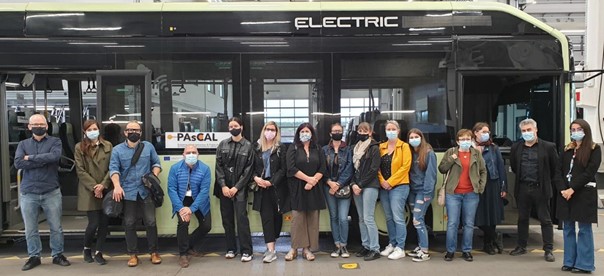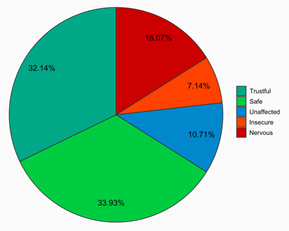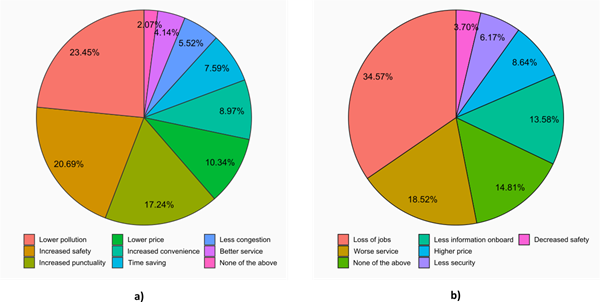
- Advantages and unknowns in Public Transport Automation

Benefits and challenges of public transport automation
Road safety and environmental protection are among the main perceived advantages but the need for contact to protect against the risks of criminal acts remains high.
Integration of high-capacity automated buses to public transport (PT) can reduce energy consumption, curb greenhouse gas emissions (GHG), and make bus travel smoother and safer. But there are still some challenges that go beyond automation per se, linked to the fact that that driver will disappear. These challenges were the main goal of pilot 1 of Horizon’s 2020 project PAsCAL. Following more than 6 months of preparations and tests, the pilot came to an end, and conclusions were drawn. The pilot has demonstrated that passenger acceptance of driverless automated buses is not only about perceived vehicle safety (crash risk) but also security (crime risk).

The purpose of public transport automaton
Public transport automation opens possibilities to make bus travel safer, more comfortable and more energy efficient. However, it is not a silver bullet in making buses more competitive compared to private cars. Automated buses traveling in mixed traffic will not be able to realise their full potential due to irregular traffic-flows. In the end it is about reaching a high-quality service level which includes several aspects such as commercial speed, reliability, comfort, etc. Therefore, significant environmental and societal benefits can only be achieved if automaton is combined with other bus priority measures developed under the umbrella of cooperative intelligent transportation systems [1]. One of the main questions addressed in the Luxembourg pilot was how the lack of a driver will impact the perceived service level, security and safety, as well as to what extent the shortcomings can be addressed by digitalised solutions allowing video/voice connections with a public transport control center (ICT support).

The method
To provide the participants with a vision of a future where automation is perfected, a so called “Wizard of Oz” approach was used. That is a research experiment in which the subjects interact with a computer system that they consider totally autonomous, but which is actually managed or partially managed by a hidden human being. Following this approach, a 12m bus was prepared in a way that passengers believed that they travelled in driverless automated/autonomous bus. This allowed to execute advanced scenarios with other traffic near the bus, that would not be feasible using today’s state of automation. The scenarios designed varied in that some experienced operational related events and some had extended ICT support in addition.
The main results
A total of 5 main experiments involving 51 participants were carried out. There were 25 female and 26 male participants with an average age of 46 and 40 respectively. The youngest participant was 18 years old, the oldest 73. Moreover, five participants who had visual impairments experienced a simple scenario without events. Finally, two special experiments focusing on driving alone and at night were carried out involving 3 additional participants. When asked about their feelings related to the experiment the feelings trustful and safe occurred three times more than insecure and nervous, indicating a general positive experience. The feelings insecure and nervous combined were still quite prevalent, though one could notice a light decrease in these negatives feelings for people who experienced the scenario with ICT support. Hence, the ICT support helped people feel less nervous.


When it comes to overall attitude towards using driverless buses, all except one person would be willing to use them and let family and close ones use them. Among the positive responses, 54% would certainly use such buses, 24% probably and 22% would use it conditionally, depending on how the technology evolves.

Increased safety and lower negative environmental impact were among the highest perceived benefits (20.69% and 23.45%). On the other hand, loss of jobs and worse service were among the top perceived drawbacks of automation. Lower expected security was reported only by 3.7% responders. However, security-related issues were not tested in the experiments. In the explicit questions related to unusual situations a majority (68.63%) of responders agreed that handling of emerging situations without a driver will be more difficult. Although, the lack of access to information via a driver was not an issue to 41.18% responders, it was reported as stressful by a relatively large group (35.29%). Risk of decreased safety (violence, pickpocketing, etc.) was noted by 43.14% participants, with almost 20% of them being undecided. Almost everyone agreed (98.04%) that on-demand contact with a control center is important.

Conclusions
Trust towards automation technology is only a pre-requisite for passenger acceptance of automated buses in public transport. The experiments reported confirm that passengers generally accept the technology and appreciate safety and environmental benefits. The main perceived drawbacks were loss of jobs and lower service quality due to lack of a driver present in the bus. However, one can expect that digitalisation will be able to fill in the service gaps – the market for mobile apps facilitating seamless intermodal travel is constantly growing and will most likely be able to provide innovative solutions to driverless bus operations. One must note special requirements by passengers with disabilities, who will need additional forms of communication with the bus that include requirements such as dwell time extension.
Coming then to the question of the role of drivers, in consideration of the current shortage of these professional figures - a problem now widespread also in the field of public transport, the impact of autonomous driving technologies might be lower than generally perceived. Moreover, new jobs will be generated with the rise of autonomous bus operations. Results of the PAsCAL project indicate that drivers play an important role that goes beyond operating the vehicle. They are expected to assist in various situations so as to guarantee a certain degree of experienced safety in relation to other passengers. However, it appears that in typical daylight operations with several passengers on board, the on-demand and proactive support provided by a control center will be sufficient. Finally, one must keep in mind that the technology alone is not a silver bullet in making PT more attractive. An autonomous bus operating in mixed traffic will only be marginally more attractive than a conventional bus (potentially smoother operations). Hence, PT automation shall be seen as rather an enabler of new applications developed within a C-ITS framework to efficiently prioritize PT in traffic flows to make it an attractive choice.